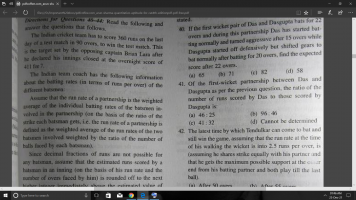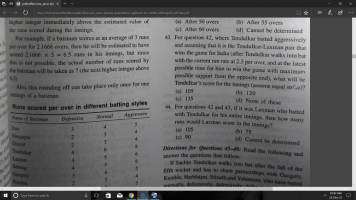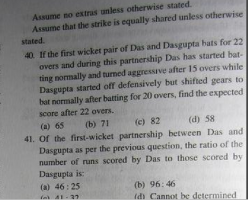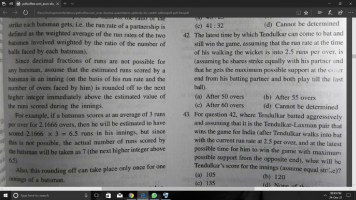But , question was asked about estimated score after 22 overs so it will be 141 runs
141 is the expected score of
44 overs (22 from Das and 22 from Dasgupta), not 22. The question asks the expected score after 22 overs, so you take the average of both batters. Since each contributed evenly, 22/44=>1/2; then the weighted average becomes a simple average=> 141/2.
The question should be rephrased to " run rate of each batsman in partnership " then i would have done :
Avg run rate per batsman = Sum of the runs of 2 batsman / No of batsman
If the question asked: "What's the run rate of
each batmans in the partnership?" then you would need two answers. The answer would've been
E[runs |Das] = 15*4 + 5*7 = 95
E[runs |Dasgupta] = 20*2 +2*3 = 46
They have said in the question
run rate of a partnership = Wt avg of run rates of two batsman involved weighted by ratio of no of balls faced by each batsman .
What does it mean in this case?
I am unfamiliar with cricket, so I don't know what "the number of balls faced by each batsman" means. Maybe
@Subhotosh Khan can explain. But the general idea of weighted average is to assign heavier weights to the player who contributes more, and vice versa.
[math]Wt(Das)=\frac{\text{number of ball Das faced}}{\text{total balls both faced}}[/math]Similarly,
[math]Wt(Dasgupta)=\frac{\text{number of ball Dasgupta faced}}{\text{total balls both faced}}[/math]As you can see, if Das faced more balls than Dasgupta, whatever that means, Das would have greater weight as he contributed more to the partnership.
The sum of weights must always equal 1, and a simple average is a particular case of weighted average where all the weights are equal.
[math]Wt(Das) + Wt(Dasgupta) =1[/math]




